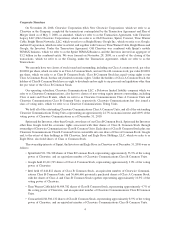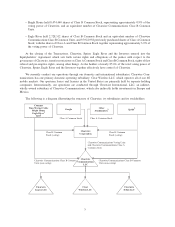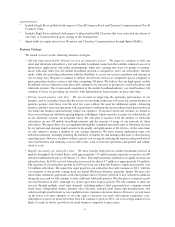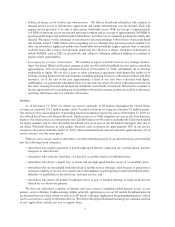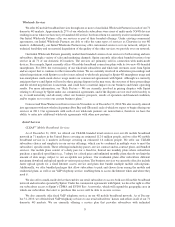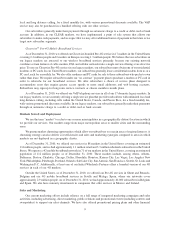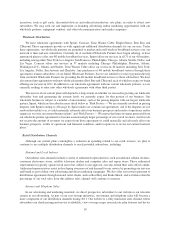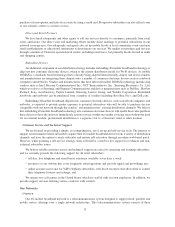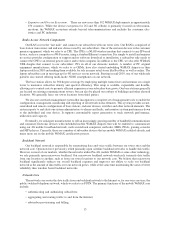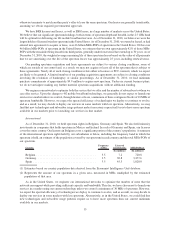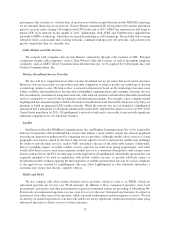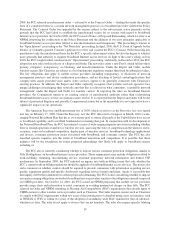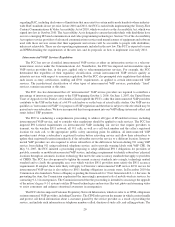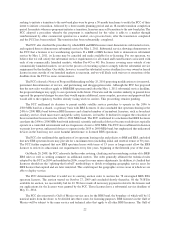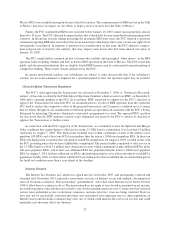Clearwire 2010 Annual Report Download - page 18
Download and view the complete annual report
Please find page 18 of the 2010 Clearwire annual report below. You can navigate through the pages in the report by either clicking on the pages listed below, or by using the keyword search tool below to find specific information within the annual report.•Expansive and Diverse Ecosystem. There are now more than 592 WiMAX deployments in approximately
150 countries. While the device ecosystem for 2G and 3G cellular is primarily focused on telecommu-
nications, the WiMAX ecosystem extends beyond telecommunications and includes the consumer elec-
tronics and PC industries.
Radio Access Network Components
Our RAN covers the “last mile” and connects our subscribers with our tower sites. Our RAN is comprised of
base station transceivers and end user devices used by our subscribers. One of the end user devices is the customer
premise equipment, which we refer to as CPE. The CPE is a NLOS wireless modem that connects to any IP-based
device, such as a computer or a Wi-Fi router, using a standard Ethernet connection. It is simple to install and requires
no service provider configuration or support and no software download or installation, a subscriber only needs to
connect the CPE to an external power source and to their computer. In addition to the CPE, we also offer WiMAX
USB dongles that connect to our subscribers’ PCs in all of our domestic markets. A number of PC original
equipment manufacturers, which we refer to as OEMs, have also started embedding WiMAX chipsets in their
laptop models in 2010 and making them available for sale in major retail stores like Best Buy as well as online. The
laptop subscribers can in turn sign up for 4G services on our network. Starting in mid-2010, one of our wholesale
partners also started offering multi-mode 3G/4G smartphones on our network.
The base station allows for 360 degree coverage by employing multiple transceivers and antennas on a single
tower to maximize subscriber density and spectral efficiency. This setup is scalable, expandable and flexible,
allowing us to control costs to promote efficient expansion as our subscriber base grows. Our base stations generally
are located on existing communications towers, but can also be placed on rooftops of buildings and other elevated
locations. We generally lease our tower locations from third parties.
We also use a network management system that incorporates a complete set of management tools to enable the
configuration, management, monitoring and reporting of all network status elements. This system provides secure,
centralized and remote configuration of base stations, end user devices, switches and other network elements. The
system reports to and alerts our system administrators to alarms and faults, and monitors system performance down
to the individual end user device. It supports customizable report generation to track network performance,
utilization and capacity.
Eventually, we anticipate manufacturers to sell an increasingly growing number of handheld communications
and consumer electronic devices with embedded mobile WiMAX chipsets that will be enabled to communicate
using our 4G mobile broadband network, such as notebook computers, netbooks, MIDs, PDAs, gaming consoles
and MP3 players. Currently, there are a number of subscriber devices that are mobile WiMAX certified already, and
many more are in the mobile WiMAX certification process.
Backhaul Network
Our backhaul network is responsible for transmitting data and voice traffic between our tower sites and the
network core. Operators have previously relied primarily upon wireline backhaul networks to handle this traffic.
However, in most of our markets, whether the networks utilize Pre-4G, mobile WiMAX or some other technology,
we rely primarily upon microwave backhaul. Our microwave backhaul network wirelessly transmits data traffic
from one location to another, such as from our tower locations to our network core. We believe that microwave
backhaul significantly reduces our overall backhaul expenses and improves our ability to scale our backhaul
network as the amount of data traffic over our network grows, while at the same time maintaining the same or better
reliability than wireline based backhaul networks.
Network Core
The network core routes the data traffic from our backhaul network to the Internet or, for our voice services, the
public switched telephone network, which we refer to as PSTN. The primary functions of the mobile WiMAX core
include:
• authenticating and authorizing subscribers;
• aggregating and routing traffic to and from the Internet;
• subscriber provisioning and billing;
13



